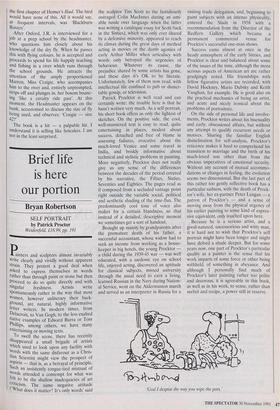Brief life is here our portion
Bryan Robertson
SELF PORTRAIT by Patrick Proctor Weidenfeld, £18.99, pp. 191 sinters and sculptors almost invariably write clearly and vividly without apparent strain. They protest a good deal when asked to express themselves in words rather than through paint or stone but then proceed to do so quite directly and with singular freshness. Artists write spontaneously rather in the way that most Women, however unliterary their back- ground, are natural, highly informative letter writers. In modern times, from Delacroix, to Van Gogh, to the less exalted native examples of Edward Burra or Tom Phillips, among others, we have many entertaining or moving texts.
To swell the scene, there has recently disappeared a small brigade of artists which used to look upon any facility with Words with the same disfavour as a Chris- tian Scientist might view the prospect of aspirin — that is, as a betrayal of principle. Such an insistently tongue-tied mistrust of words attended a contempt for what was felt to be the shallow inadequacies of art criticism. The same negative attitude ( What does it matter? It's only words' said the sculptor Tim Scott to the fastidiously outraged Colin Maclnnes during an ami- able tussle over language when the latter was writing a catalogue essay for Scott back in the Sixties), which was only ever shared by a defensive minority, appeared to reach its climax during the great days of method acting in movies or the dumb agonies of early Arthur Miller when articulacy with words only betrayed the urgencies of behaviour. Whatever its cause, the prejudice shared by some artists has gone, and these days it's OK to be literate. Unfortunately, few of them now read, with intellectual life confined to pub or dinner- table gossip, or television.
Patrick Procktor is well read and can certainly write: the trouble here is that he hasn't written very much. As a self-portrait, his short book offers us only the lightest of sketches. On the positive side, the cool, well-mannered text is easy to read, quite entertaining in places, modest about success, detached and free of blame in assessing failures, evocative about the much-loved Venice and some travel in India, and briskly informative about technical and stylistic problems in painting. More negatively, Procktor does not really give us any sense of the differences between the decades of the period covered by his narrative, the Fifties, Sixties, Seventies and Eighties. The pages read as if composed from a secluded vantage point right outside the variable social, political and aesthetic shading of the time-flux. The predominantly cool tone of voice also makes for a certain blandness, so that instead of a detailed, descriptive memoir we sometimes get a sort of handout.
Brought up mainly by grandparents after the premature death of his father, a successful accountant, whose widow had to seek an income from working as a house- keeper in big hotels, the young Procktor a child during the 1939-45 war — was well educated, with a sardonic eye on school life, enjoyed acting, discovered an aptitude for classical subjects, missed university through the usual need to earn a living, learned Russian in the Navy during Nation- al Service, went on the Aldermaston march and served as an interpreter in Russia for a visiting trade delegation, and, beginning to paint subjects with an intense physicality, entered the Slade in 1958 with a recommendation from the Director of the Redfern Gallery which became a permanent commercial venue for Procktor's successful one-man shows.
Success came almost at once in the heady atmosphere of the early Sixties, and Procktor is clear and balanced about some of the issues of the time, although the more serious aspects of American art are rather grudgingly noted. His friendships with fellow figurative artists are recorded, with David Hockney, Mario Dubsky and Keith Vaughan, for example. He is good also on the practical mechanics of being an artist, and acute and nicely ironical about the problems of portraiture.
On the side of personal life and involve- ments, Procktor writes about his bisexuality and early, obsessional affairs, but without any attempt to qualify recurrent needs or motives. Sharing the familiar English disinclination for self-analysis, Procktor's reticence makes it hard to comprehend his transition to marriage and the birth of his much-loved son other than from the obvious imperatives of emotional security. Without any account of mutual accommo- dations or changes in feeling, the evolution seems two dimensional. But the last part of this rather too gently reflective book has a particular sadness, with the death of Prock- tor's wife, her ex-partner Peter Langan — a patron of Procktor's — and a sense of moving away from the physical urgency of his earlier painting to some kind of expres- sive equivalent, only touched upon here.
Because he is a serious artist, and a good-natured, uncensorious and witty man, it is hard not to wish that Procktor's self portrait might have been longer and might have delved a shade deeper. But for some years now, one part of Procktor's particular quality as a painter is the sense that his work imparts of some force or other being withheld, of something in abeyance. And although I personally find much of Procktor's later painting rather too polite and decorous, it is agreeable in this book, as well as in his work, to sense, rather than surfeit and recipe, a power still in reserve.
'God 1 despise the way you wipe the pots.'










































































 Previous page
Previous page